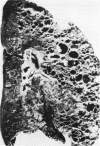Abstract
Most survivors of ARDS have persistent mild reductions of TLCO even as long as a year after their episode. The lung volumes and flows return to normal in most instances, although a subset of patients will have persistent impairment. Both obstructive and restrictive deficits may be seen. This group may be predicted by the degree of acute lung injury assessed by the level of FIO2, PEEP, and gas exchange abnormality that exists in the first few days. In the first year after ARDS most physiological abnormalities will improve, but if deficits persist at one year further improvement is unlikely. Although many patients report dyspnoea following ARDS, the symptom does not correlate with abnormalities of pulmonary function. The possibility that conventional management may augment the degree of acute injury and worsen outcome must be considered. The effects of chronic hyperoxia in humans with acute lung injury or those of high levels of PEEP compared with low levels are not known. Exploring new ventilator management strategies while we await more specific treatment directed at the primary problem of acute lung inflammation will hopefully reduce acute mortality as well as acute and chronic morbidity.
Full text
PDF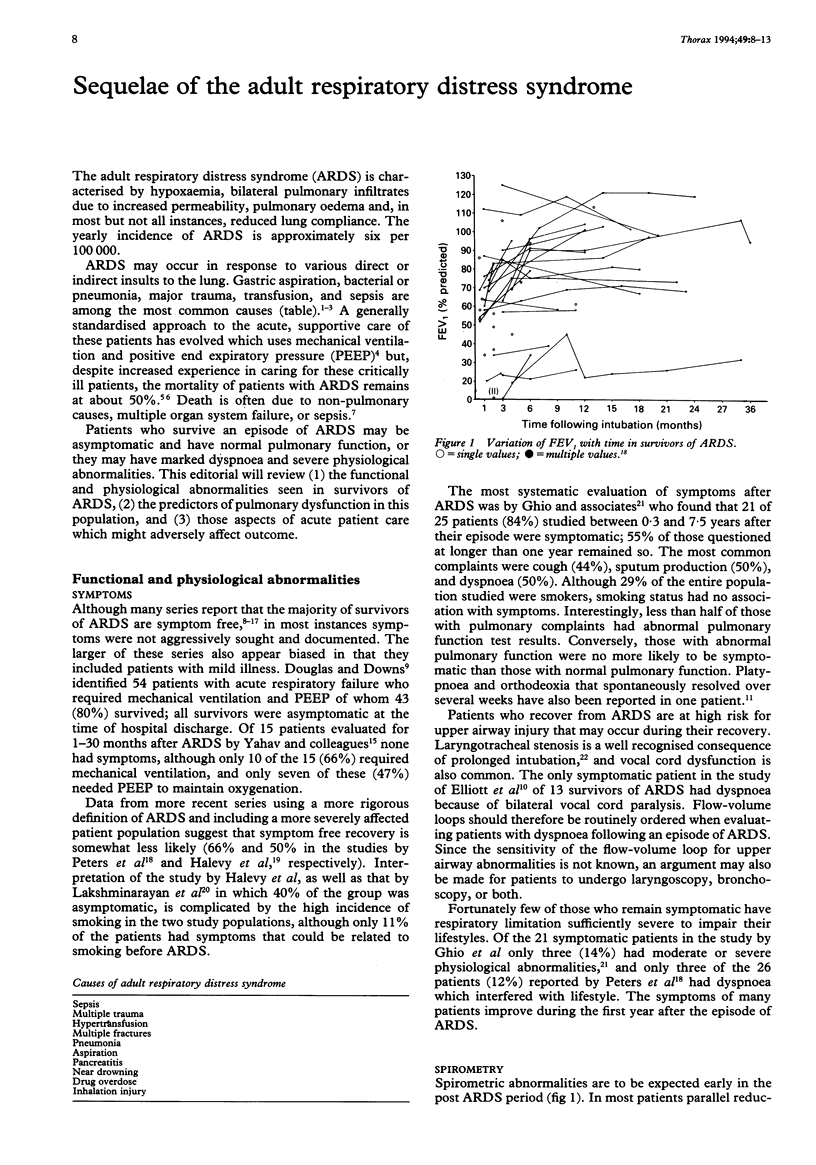
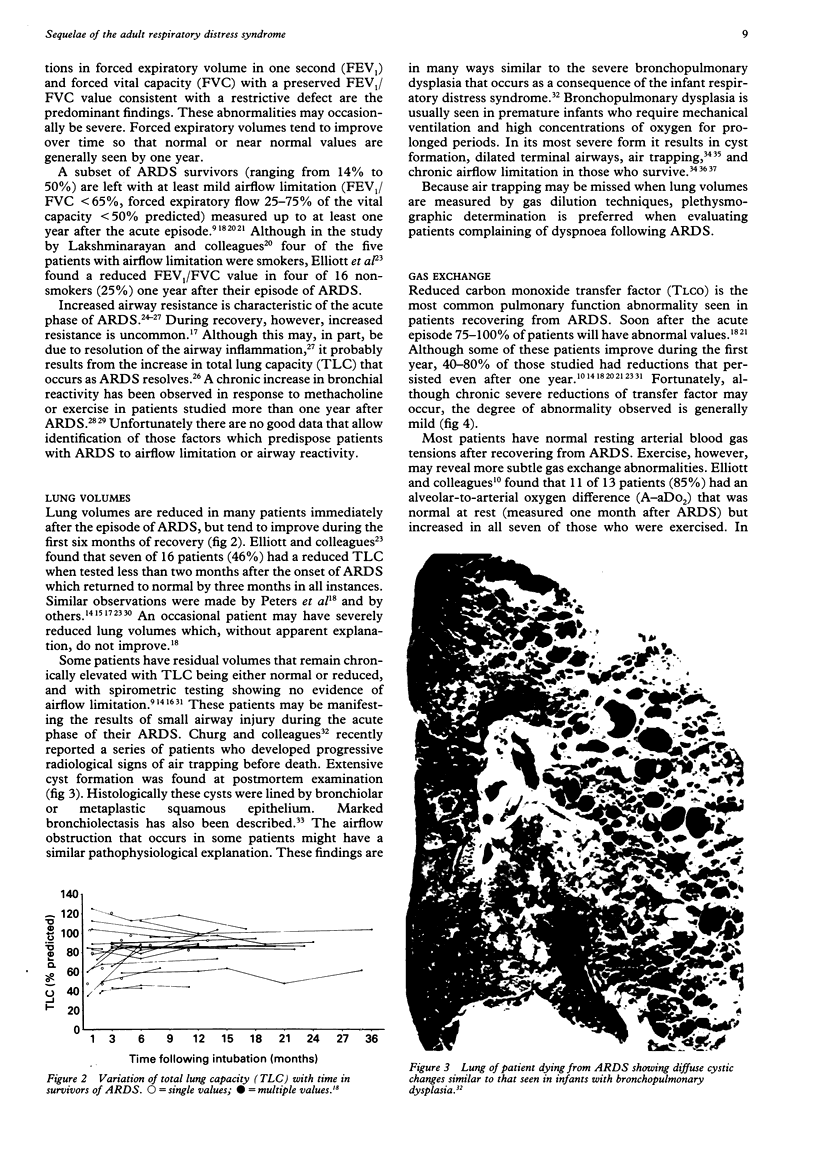
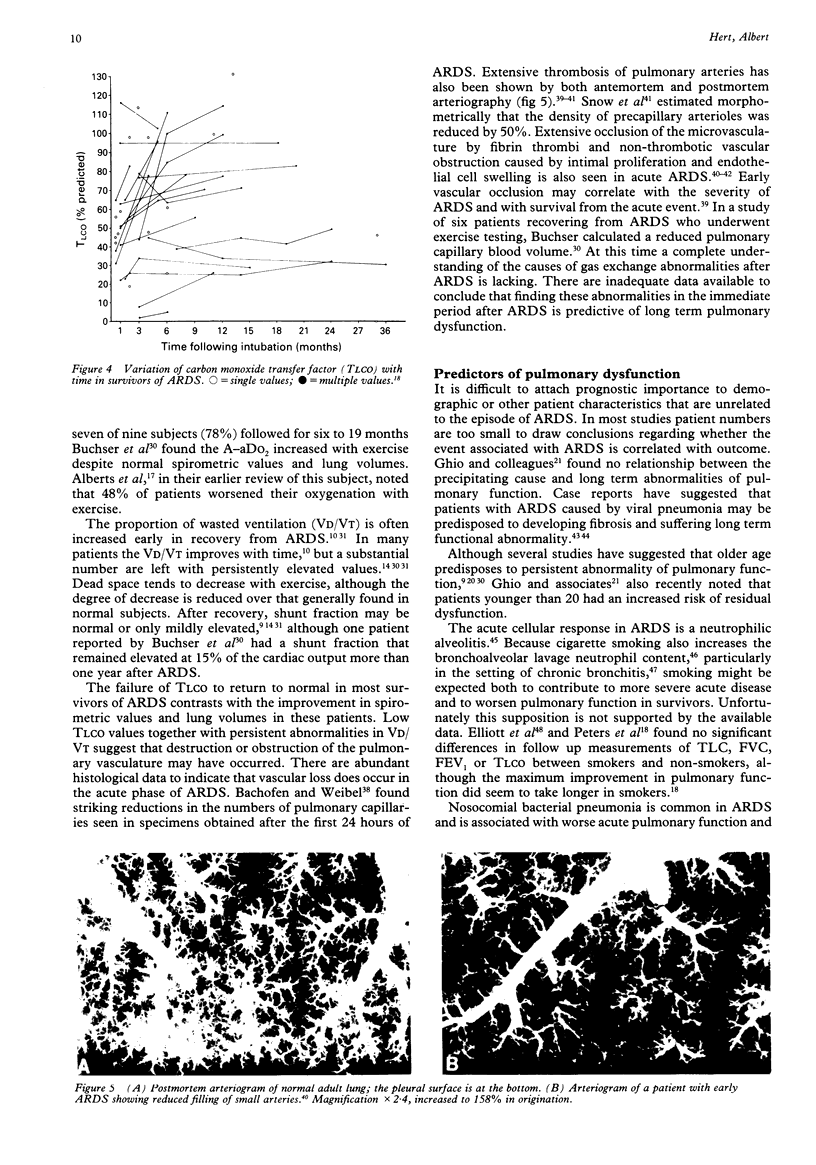

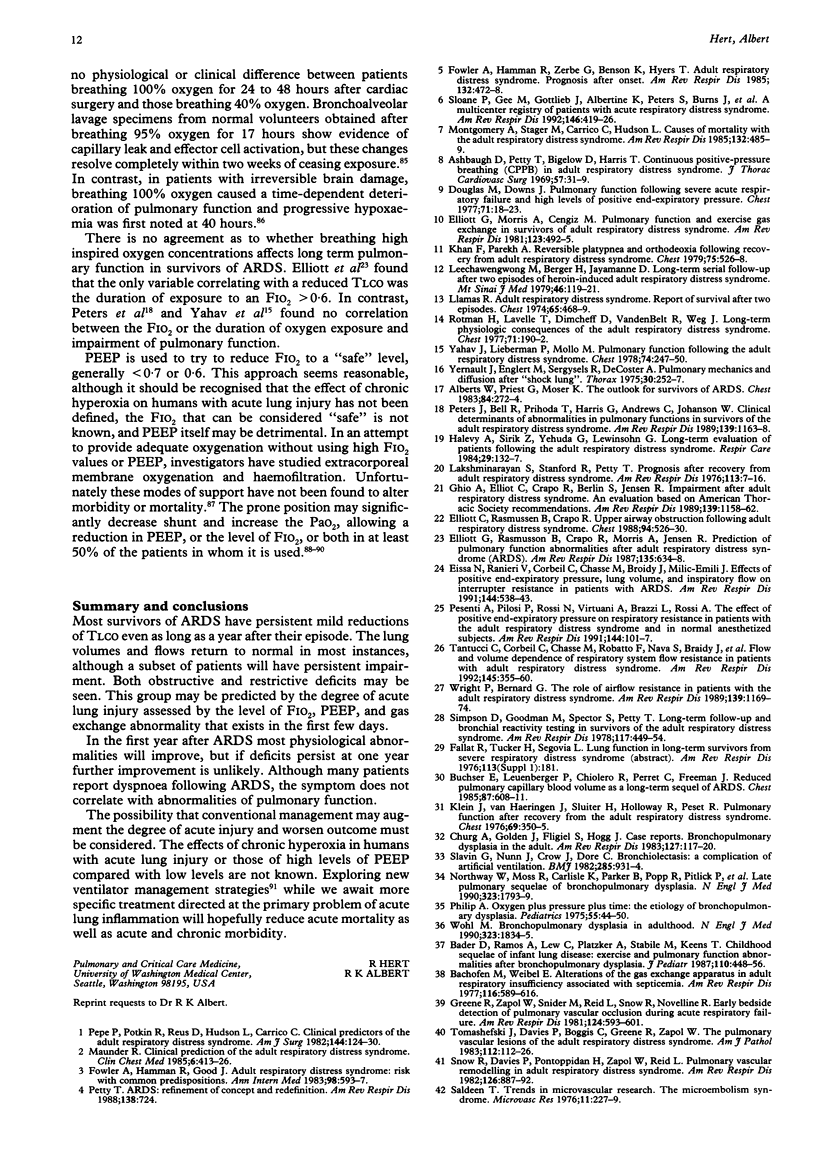

Images in this article
Selected References
These references are in PubMed. This may not be the complete list of references from this article.
- Albert R. K., Lakshminarayan S., Kirk W., Butler J. Lung inflation can cause pulmonary edema in zone I of in situ dog lungs. J Appl Physiol Respir Environ Exerc Physiol. 1980 Nov;49(5):815–819. doi: 10.1152/jappl.1980.49.5.815. [DOI] [PubMed] [Google Scholar]
- Albert R. K., Leasa D., Sanderson M., Robertson H. T., Hlastala M. P. The prone position improves arterial oxygenation and reduces shunt in oleic-acid-induced acute lung injury. Am Rev Respir Dis. 1987 Mar;135(3):628–633. doi: 10.1164/arrd.1987.135.3.628. [DOI] [PubMed] [Google Scholar]
- Alberts W. M., Priest G. R., Moser K. M. The outlook for survivors of ARDS. Chest. 1983 Sep;84(3):272–274. doi: 10.1378/chest.84.3.272. [DOI] [PubMed] [Google Scholar]
- Ashbaugh D. G., Petty T. L. Sepsis complicating the acute respiratory distress syndrome. Surg Gynecol Obstet. 1972 Dec;135(6):865–869. [PubMed] [Google Scholar]
- Bachofen M., Weibel E. R. Alterations of the gas exchange apparatus in adult respiratory insufficiency associated with septicemia. Am Rev Respir Dis. 1977 Oct;116(4):589–615. doi: 10.1164/arrd.1977.116.4.589. [DOI] [PubMed] [Google Scholar]
- Barber R. E., Hamilton W. K. Oxygen toxicity in man. A A/Barber RE, Lee J, Hamilton WK: Oxygen toxicity in man. A prospective study in patients with irreversible brain damage. N Engl J Med. 1970 Dec 31;283(27):1478–1484. doi: 10.1056/NEJM197012312832702. [DOI] [PubMed] [Google Scholar]
- Bell R. C., Coalson J. J., Smith J. D., Johanson W. G., Jr Multiple organ system failure and infection in adult respiratory distress syndrome. Ann Intern Med. 1983 Sep;99(3):293–298. doi: 10.7326/0003-4819-99-3-293. [DOI] [PubMed] [Google Scholar]
- Bshouty Z., Ali J., Younes M. Effect of tidal volume and PEEP on rate of edema formation in in situ perfused canine lobes. J Appl Physiol (1985) 1988 May;64(5):1900–1907. doi: 10.1152/jappl.1988.64.5.1900. [DOI] [PubMed] [Google Scholar]
- Campbell G. D., Coalson J. J., Johanson W. G., Jr The effect of bacterial superinfection on lung function after diffuse alveolar damage. Am Rev Respir Dis. 1984 Jun;129(6):974–978. doi: 10.1164/arrd.1984.129.6.974. [DOI] [PubMed] [Google Scholar]
- Chaisson R. E., Hopewell P. C. Mycobacteria and AIDS mortality. Am Rev Respir Dis. 1989 Jan;139(1):1–3. doi: 10.1164/ajrccm/139.1.1. [DOI] [PubMed] [Google Scholar]
- Chaisson R. E., Hopewell P. C. Mycobacteria and AIDS mortality. Am Rev Respir Dis. 1989 Jan;139(1):1–3. doi: 10.1164/ajrccm/139.1.1. [DOI] [PubMed] [Google Scholar]
- Cheney F. W., Huang T. W., Gronka R. The effects of 50% oxygen on the resolution of pulmonary injury. Am Rev Respir Dis. 1980 Sep;122(3):373–379. doi: 10.1164/arrd.1980.122.3.373. [DOI] [PubMed] [Google Scholar]
- Corbridge T. C., Wood L. D., Crawford G. P., Chudoba M. J., Yanos J., Sznajder J. I. Adverse effects of large tidal volume and low PEEP in canine acid aspiration. Am Rev Respir Dis. 1990 Aug;142(2):311–315. doi: 10.1164/ajrccm/142.2.311. [DOI] [PubMed] [Google Scholar]
- Crouch T. W., Higuchi J. H., Coalson J. J., Johanson W. G., Jr Pathogenesis and prevention of nosocomial pneumonia in a nonhuman primate model of acute respiratory failure. Am Rev Respir Dis. 1984 Sep;130(3):502–504. doi: 10.1164/arrd.1984.130.3.502. [DOI] [PubMed] [Google Scholar]
- Darioli R., Perret C. Mechanical controlled hypoventilation in status asthmaticus. Am Rev Respir Dis. 1984 Mar;129(3):385–387. doi: 10.1164/arrd.1984.129.3.385. [DOI] [PubMed] [Google Scholar]
- Davis W. B., Rennard S. I., Bitterman P. B., Crystal R. G. Pulmonary oxygen toxicity. Early reversible changes in human alveolar structures induced by hyperoxia. N Engl J Med. 1983 Oct 13;309(15):878–883. doi: 10.1056/NEJM198310133091502. [DOI] [PubMed] [Google Scholar]
- Demling R. H., Staub N. C., Edmunds L. H., Jr Effect of end-expiratory airway pressure on accumulation of extravascular lung water. J Appl Physiol. 1975 May;38(5):907–912. doi: 10.1152/jappl.1975.38.5.907. [DOI] [PubMed] [Google Scholar]
- Deneke S. M., Fanburg B. L. Normobaric oxygen toxicity of the lung. N Engl J Med. 1980 Jul 10;303(2):76–86. doi: 10.1056/NEJM198007103030204. [DOI] [PubMed] [Google Scholar]
- Douglas M. E., Downs J. B. Pulmonary function following severe acute respiratory failure and high levels of positive end-expiratory pressure. Chest. 1977 Jan;71(1):18–23. doi: 10.1378/chest.71.1.18. [DOI] [PubMed] [Google Scholar]
- Douglas W. W., Rehder K., Beynen F. M., Sessler A. D., Marsh H. M. Improved oxygenation in patients with acute respiratory failure: the prone position. Am Rev Respir Dis. 1977 Apr;115(4):559–566. doi: 10.1164/arrd.1977.115.4.559. [DOI] [PubMed] [Google Scholar]
- Dreyfuss D., Basset G., Soler P., Saumon G. Intermittent positive-pressure hyperventilation with high inflation pressures produces pulmonary microvascular injury in rats. Am Rev Respir Dis. 1985 Oct;132(4):880–884. doi: 10.1164/arrd.1985.132.4.880. [DOI] [PubMed] [Google Scholar]
- Elliott C. G., Morris A. H., Cengiz M. Pulmonary function and exercise gas exchange in survivors of adult respiratory distress syndrome. Am Rev Respir Dis. 1981 May;123(5):492–495. doi: 10.1164/arrd.1981.123.5.492. [DOI] [PubMed] [Google Scholar]
- Elliott C. G., Rasmusson B. Y., Crapo R. O., Morris A. H., Jensen R. L. Prediction of pulmonary function abnormalities after adult respiratory distress syndrome (ARDS). Am Rev Respir Dis. 1987 Mar;135(3):634–638. doi: 10.1164/arrd.1987.135.3.634. [DOI] [PubMed] [Google Scholar]
- Elliott C. G., Rasmusson B. Y., Crapo R. O., Morris A. H., Jensen R. L. Prediction of pulmonary function abnormalities after adult respiratory distress syndrome (ARDS). Am Rev Respir Dis. 1987 Mar;135(3):634–638. doi: 10.1164/arrd.1987.135.3.634. [DOI] [PubMed] [Google Scholar]
- Elliott C. G., Rasmusson B. Y., Crapo R. O. Upper airway obstruction following adult respiratory distress syndrome. An analysis of 30 survivors. Chest. 1988 Sep;94(3):526–530. doi: 10.1378/chest.94.3.526. [DOI] [PubMed] [Google Scholar]
- Elliott C. G., Rasmusson B. Y., Crapo R. O. Upper airway obstruction following adult respiratory distress syndrome. An analysis of 30 survivors. Chest. 1988 Sep;94(3):526–530. doi: 10.1378/chest.94.3.526. [DOI] [PubMed] [Google Scholar]
- Fowler A. A., Hamman R. F., Good J. T., Benson K. N., Baird M., Eberle D. J., Petty T. L., Hyers T. M. Adult respiratory distress syndrome: risk with common predispositions. Ann Intern Med. 1983 May;98(5 Pt 1):593–597. doi: 10.7326/0003-4819-98-5-593. [DOI] [PubMed] [Google Scholar]
- Fowler A. A., Hamman R. F., Zerbe G. O., Benson K. N., Hyers T. M. Adult respiratory distress syndrome. Prognosis after onset. Am Rev Respir Dis. 1985 Sep;132(3):472–478. doi: 10.1164/arrd.1985.132.3.472. [DOI] [PubMed] [Google Scholar]
- Fowler A. A., Hamman R. F., Zerbe G. O., Benson K. N., Hyers T. M. Adult respiratory distress syndrome. Prognosis after onset. Am Rev Respir Dis. 1985 Sep;132(3):472–478. doi: 10.1164/arrd.1985.132.3.472. [DOI] [PubMed] [Google Scholar]
- Frank L., Bucher J. R., Roberts R. J. Oxygen toxicity in neonatal and adult animals of various species. J Appl Physiol Respir Environ Exerc Physiol. 1978 Nov;45(5):699–704. doi: 10.1152/jappl.1978.45.5.699. [DOI] [PubMed] [Google Scholar]
- Gattinoni L., Pelosi P., Pesenti A., Brazzi L., Vitale G., Moretto A., Crespi A., Tagliabue M. CT scan in ARDS: clinical and physiopathological insights. Acta Anaesthesiol Scand Suppl. 1991;95:87–96. doi: 10.1111/j.1399-6576.1991.tb03404.x. [DOI] [PubMed] [Google Scholar]
- Gattinoni L., Pesenti A., Bombino M., Baglioni S., Rivolta M., Rossi F., Rossi G., Fumagalli R., Marcolin R., Mascheroni D. Relationships between lung computed tomographic density, gas exchange, and PEEP in acute respiratory failure. Anesthesiology. 1988 Dec;69(6):824–832. doi: 10.1097/00000542-198812000-00005. [DOI] [PubMed] [Google Scholar]
- Greene R., Zapol W. M., Snider M. T., Reid L., Snow R., O'Connell R. S., Novelline R. A. Early bedside detection of pulmonary vascular occlusion during acute respiratory failure. Am Rev Respir Dis. 1981 Nov;124(5):593–601. doi: 10.1164/arrd.1981.124.5.593. [DOI] [PubMed] [Google Scholar]
- Hayatdavoudi G., O'Neil J. J., Barry B. E., Freeman B. A., Crapo J. D. Pulmonary injury in rats following continuous exposure to 60% O2 for 7 days. J Appl Physiol Respir Environ Exerc Physiol. 1981 Nov;51(5):1220–1231. doi: 10.1152/jappl.1981.51.5.1220. [DOI] [PubMed] [Google Scholar]
- Hernandez L. A., Coker P. J., May S., Thompson A. L., Parker J. C. Mechanical ventilation increases microvascular permeability in oleic acid-injured lungs. J Appl Physiol (1985) 1990 Dec;69(6):2057–2061. doi: 10.1152/jappl.1990.69.6.2057. [DOI] [PubMed] [Google Scholar]
- Hernandez L. A., Peevy K. J., Moise A. A., Parker J. C. Chest wall restriction limits high airway pressure-induced lung injury in young rabbits. J Appl Physiol (1985) 1989 May;66(5):2364–2368. doi: 10.1152/jappl.1989.66.5.2364. [DOI] [PubMed] [Google Scholar]
- Hickling K. G., Henderson S. J., Jackson R. Low mortality associated with low volume pressure limited ventilation with permissive hypercapnia in severe adult respiratory distress syndrome. Intensive Care Med. 1990;16(6):372–377. doi: 10.1007/BF01735174. [DOI] [PubMed] [Google Scholar]
- Khan F., Parekh A. Reversible platypnea and orthodeoxia following recovery from adult respiratory distress syndrome. Chest. 1979 Apr;75(4):526–528. doi: 10.1378/chest.75.4.526. [DOI] [PubMed] [Google Scholar]
- Klein J. J., van Haeringen J. R., Sluiter H. J., Holloway R., Peset R. Pulmonary function after recovery from the adult respiratory distress syndrome. Chest. 1976 Mar;69(3):350–355. doi: 10.1378/chest.69.3.350. [DOI] [PubMed] [Google Scholar]
- Kolobow T., Moretti M. P., Fumagalli R., Mascheroni D., Prato P., Chen V., Joris M. Severe impairment in lung function induced by high peak airway pressure during mechanical ventilation. An experimental study. Am Rev Respir Dis. 1987 Feb;135(2):312–315. doi: 10.1164/arrd.1987.135.2.312. [DOI] [PubMed] [Google Scholar]
- Lakshminarayan S., Stanford R. E., Petty T. L. Prognosis after recovery from adult respiratory distress syndrome. Am Rev Respir Dis. 1976 Jan;113(1):7–16. doi: 10.1164/arrd.1976.113.1.7. [DOI] [PubMed] [Google Scholar]
- Langer M., Mascheroni D., Marcolin R., Gattinoni L. The prone position in ARDS patients. A clinical study. Chest. 1988 Jul;94(1):103–107. doi: 10.1378/chest.94.1.103. [DOI] [PubMed] [Google Scholar]
- Llamas R. Adult respiratory distress syndrome. Report of survival after two episodes. Chest. 1974 Apr;65(4):468–469. doi: 10.1378/chest.65.4.468. [DOI] [PubMed] [Google Scholar]
- Marini J. J., Kelsen S. G. Re-targeting ventilatory objectives in adult respiratory distress syndrome. New treatment prospects--persistent questions. Am Rev Respir Dis. 1992 Jul;146(1):2–3. doi: 10.1164/ajrccm/146.1.2. [DOI] [PubMed] [Google Scholar]
- Martin T. R., Raghu G., Maunder R. J., Springmeyer S. C. The effects of chronic bronchitis and chronic air-flow obstruction on lung cell populations recovered by bronchoalveolar lavage. Am Rev Respir Dis. 1985 Aug;132(2):254–260. doi: 10.1164/arrd.1985.132.2.254. [DOI] [PubMed] [Google Scholar]
- Maunder R. J. Clinical prediction of the adult respiratory distress syndrome. Clin Chest Med. 1985 Sep;6(3):413–426. [PubMed] [Google Scholar]
- McClenahan J. B., Urtnowski A. Effect of ventilation on surfactant, and its turnover rate. J Appl Physiol. 1967 Aug;23(2):215–220. doi: 10.1152/jappl.1967.23.2.215. [DOI] [PubMed] [Google Scholar]
- Montgomery A. B., Stager M. A., Carrico C. J., Hudson L. D. Causes of mortality in patients with the adult respiratory distress syndrome. Am Rev Respir Dis. 1985 Sep;132(3):485–489. doi: 10.1164/arrd.1985.132.3.485. [DOI] [PubMed] [Google Scholar]
- Northway W. H., Jr, Moss R. B., Carlisle K. B., Parker B. R., Popp R. L., Pitlick P. T., Eichler I., Lamm R. L., Brown B. W., Jr Late pulmonary sequelae of bronchopulmonary dysplasia. N Engl J Med. 1990 Dec 27;323(26):1793–1799. doi: 10.1056/NEJM199012273232603. [DOI] [PubMed] [Google Scholar]
- Northway W. H., Jr, Moss R. B., Carlisle K. B., Parker B. R., Popp R. L., Pitlick P. T., Eichler I., Lamm R. L., Brown B. W., Jr Late pulmonary sequelae of bronchopulmonary dysplasia. N Engl J Med. 1990 Dec 27;323(26):1793–1799. doi: 10.1056/NEJM199012273232603. [DOI] [PubMed] [Google Scholar]
- Pang L. M., Rodriguez-Martinez F., Stalcup S. A., Mellins R. B. Effect of hyperinflation and atelectasis on fluid accumulation in the puppy lung. J Appl Physiol Respir Environ Exerc Physiol. 1978 Aug;45(2):284–288. doi: 10.1152/jappl.1978.45.2.284. [DOI] [PubMed] [Google Scholar]
- Parker J. C., Hernandez L. A., Longenecker G. L., Peevy K., Johnson W. Lung edema caused by high peak inspiratory pressures in dogs. Role of increased microvascular filtration pressure and permeability. Am Rev Respir Dis. 1990 Aug;142(2):321–328. doi: 10.1164/ajrccm/142.2.321. [DOI] [PubMed] [Google Scholar]
- Parker J. C., Townsley M. I., Rippe B., Taylor A. E., Thigpen J. Increased microvascular permeability in dog lungs due to high peak airway pressures. J Appl Physiol Respir Environ Exerc Physiol. 1984 Dec;57(6):1809–1816. doi: 10.1152/jappl.1984.57.6.1809. [DOI] [PubMed] [Google Scholar]
- Paré P. D., Warriner B., Baile E. M., Hogg J. C. Redistribution of pulmonary extravascular water with positive end-expiratory pressure in canine pulmonary edema. Am Rev Respir Dis. 1983 May;127(5):590–593. doi: 10.1164/arrd.1983.127.5.590. [DOI] [PubMed] [Google Scholar]
- Pearson R. D., Hall W. J., Menegus M. A., Douglas R. G., Jr Diffuse pneumonitis due to adenovirus type 21 in a civilian. Chest. 1980 Jul;78(1):107–109. doi: 10.1378/chest.78.1.107. [DOI] [PubMed] [Google Scholar]
- Pepe P. E., Potkin R. T., Reus D. H., Hudson L. D., Carrico C. J. Clinical predictors of the adult respiratory distress syndrome. Am J Surg. 1982 Jul;144(1):124–130. doi: 10.1016/0002-9610(82)90612-2. [DOI] [PubMed] [Google Scholar]
- Pesenti A., Pelosi P., Rossi N., Virtuani A., Brazzi L., Rossi A. The effects of positive end-expiratory pressure on respiratory resistance in patients with the adult respiratory distress syndrome and in normal anesthetized subjects. Am Rev Respir Dis. 1991 Jul;144(1):101–107. doi: 10.1164/ajrccm/144.1.101. [DOI] [PubMed] [Google Scholar]
- Petty T. L. ARDS: refinement of concept and redefinition. Am Rev Respir Dis. 1988 Sep;138(3):724–724. doi: 10.1164/ajrccm/138.3.724. [DOI] [PubMed] [Google Scholar]
- Philip A. G. Oxygen plus pressure plus time: the etiology of bronchopulmonary dysplasia. Pediatrics. 1975 Jan;55(1):44–50. [PubMed] [Google Scholar]
- Philip A. G. Oxygen plus pressure plus time: the etiology of bronchopulmonary dysplasia. Pediatrics. 1975 Jan;55(1):44–50. [PubMed] [Google Scholar]
- Reynolds H. Y., Chrétien J. Respiratory tract fluids: analysis of content and contemporary use in understanding lung diseases. Dis Mon. 1984 Feb;30(5):1–103. doi: 10.1016/0011-5029(84)90008-7. [DOI] [PubMed] [Google Scholar]
- Riley D. J., Kramer M. J., Kerr J. S., Chae C. U., Yu S. Y., Berg R. A. Damage and repair of lung connective tissue in rats exposed to toxic levels of oxygen. Am Rev Respir Dis. 1987 Feb;135(2):441–447. doi: 10.1164/arrd.1987.135.2.441. [DOI] [PubMed] [Google Scholar]
- Rotman H. H., Lavelle T. F., Jr, Dimcheff D. G., VandenBelt R. J., Weg J. G. Long-term physiologic consequences of the adult respiratory distress syndrome. Chest. 1977 Aug;72(2):190–192. doi: 10.1378/chest.72.2.190. [DOI] [PubMed] [Google Scholar]
- Simpson D. L., Goodman M., Spector S. L., Petty T. L. Long-term follow-up and bronchial reactivity testing in survivors of the adult respiratory distress syndrome. Am Rev Respir Dis. 1978 Mar;117(3):449–454. doi: 10.1164/arrd.1978.117.3.449. [DOI] [PubMed] [Google Scholar]
- Singer M. M., Wright F., Stanley L. K., Roe B. B., Hamilton W. K. Oxygen toxicity in man. A prospective study in patients after open-heart surgery. N Engl J Med. 1970 Dec 31;283(27):1473–1478. doi: 10.1056/NEJM197012312832701. [DOI] [PubMed] [Google Scholar]
- Slavin G., Nunn J. F., Crow J., Doré C. J. Bronchiolectasis-a complication of artificial ventilation. Br Med J (Clin Res Ed) 1982 Oct 2;285(6346):931–934. doi: 10.1136/bmj.285.6346.931. [DOI] [PMC free article] [PubMed] [Google Scholar]
- Slavin G., Nunn J. F., Crow J., Doré C. J. Bronchiolectasis-a complication of artificial ventilation. Br Med J (Clin Res Ed) 1982 Oct 2;285(6346):931–934. doi: 10.1136/bmj.285.6346.931. [DOI] [PMC free article] [PubMed] [Google Scholar]
- Sloane P. J., Gee M. H., Gottlieb J. E., Albertine K. H., Peters S. P., Burns J. R., Machiedo G., Fish J. E. A multicenter registry of patients with acute respiratory distress syndrome. Physiology and outcome. Am Rev Respir Dis. 1992 Aug;146(2):419–426. doi: 10.1164/ajrccm/146.2.419. [DOI] [PubMed] [Google Scholar]
- Sloane P. J., Gee M. H., Gottlieb J. E., Albertine K. H., Peters S. P., Burns J. R., Machiedo G., Fish J. E. A multicenter registry of patients with acute respiratory distress syndrome. Physiology and outcome. Am Rev Respir Dis. 1992 Aug;146(2):419–426. doi: 10.1164/ajrccm/146.2.419. [DOI] [PubMed] [Google Scholar]
- Snow R. L., Davies P., Pontoppidan H., Zapol W. M., Reid L. Pulmonary vascular remodeling in adult respiratory distress syndrome. Am Rev Respir Dis. 1982 Nov;126(5):887–892. doi: 10.1164/arrd.1982.126.5.887. [DOI] [PubMed] [Google Scholar]
- Tantucci C., Corbeil C., Chasse M., Robatto F. M., Nava S., Braidy J., Matar N., Milic-Emili J. Flow and volume dependence of respiratory system flow resistance in patients with adult respiratory distress syndrome. Am Rev Respir Dis. 1992 Feb;145(2 Pt 1):355–360. doi: 10.1164/ajrccm/145.2_Pt_1.355. [DOI] [PubMed] [Google Scholar]
- Tsuno K., Prato P., Kolobow T. Acute lung injury from mechanical ventilation at moderately high airway pressures. J Appl Physiol (1985) 1990 Sep;69(3):956–961. doi: 10.1152/jappl.1990.69.3.956. [DOI] [PubMed] [Google Scholar]
- Van De Water J. M., Kagey K. S., Miller I. T., Parker D. A., O'Connor N. E., Sheh J. M., MacArthur J. D., Zollinger R. M., Jr, Moore F. D. Response of the lung to six to 12 hours of 100 per cent oxygen inhalation in normal man. N Engl J Med. 1970 Sep 17;283(12):621–626. doi: 10.1056/NEJM197009172831203. [DOI] [PubMed] [Google Scholar]
- Webb H. H., Tierney D. F. Experimental pulmonary edema due to intermittent positive pressure ventilation with high inflation pressures. Protection by positive end-expiratory pressure. Am Rev Respir Dis. 1974 Nov;110(5):556–565. doi: 10.1164/arrd.1974.110.5.556. [DOI] [PubMed] [Google Scholar]
- Winterbauer R. H., Ludwig W. R., Hammar S. P. Clinical course, management, and long-term sequelae of respiratory failure due to influenza viral pneumonia. Johns Hopkins Med J. 1977 Sep;141(3):148–155. [PubMed] [Google Scholar]
- Witschi H. R., Haschek W. M., Klein-Szanto A. J., Hakkinen P. J. Potentiation of diffuse lung damage by oxygen: determining variables. Am Rev Respir Dis. 1981 Jan;123(1):98–103. doi: 10.1164/arrd.1981.123.1.98. [DOI] [PubMed] [Google Scholar]
- Wohl M. E. Bronchopulmonary dysplasia in adulthood. N Engl J Med. 1990 Dec 27;323(26):1834–1836. doi: 10.1056/NEJM199012273232609. [DOI] [PubMed] [Google Scholar]
- Wyszogrodski I., Kyei-Aboagye K., Taeusch H. W., Jr, Avery M. E. Surfactant inactivation by hyperventilation: conservation by end-expiratory pressure. J Appl Physiol. 1975 Mar;38(3):461–466. doi: 10.1152/jappl.1975.38.3.461. [DOI] [PubMed] [Google Scholar]
- Yahav J., Lieberman P., Molho M. Pulmonary function following the adult respiratory distress syndrome. Chest. 1978 Sep;74(3):247–250. doi: 10.1378/chest.74.3.247. [DOI] [PubMed] [Google Scholar]
- Yernault J. C., Englert M., Sergysels R., De Coster A. Pulmonary mechanics and diffusion after 'shock lung'. Thorax. 1975 Jun;30(3):252–257. doi: 10.1136/thx.30.3.252. [DOI] [PMC free article] [PubMed] [Google Scholar]
- Zapol W. M., Snider M. T., Hill J. D., Fallat R. J., Bartlett R. H., Edmunds L. H., Morris A. H., Peirce E. C., 2nd, Thomas A. N., Proctor H. J. Extracorporeal membrane oxygenation in severe acute respiratory failure. A randomized prospective study. JAMA. 1979 Nov 16;242(20):2193–2196. doi: 10.1001/jama.242.20.2193. [DOI] [PubMed] [Google Scholar]
- de los Santos R., Coalson J. J., Holcomb J. R., Johanson W. G., Jr Hyperoxia exposure in mechanically ventilated primates with and without previous lung injury. Exp Lung Res. 1985;9(3-4):255–275. doi: 10.3109/01902148509057527. [DOI] [PubMed] [Google Scholar]
- de los Santos R., Seidenfeld J. J., Anzueto A., Collins J. F., Coalson J. J., Johanson W. G., Jr, Peters J. I. One hundred percent oxygen lung injury in adult baboons. Am Rev Respir Dis. 1987 Sep;136(3):657–661. doi: 10.1164/ajrccm/136.3.657. [DOI] [PubMed] [Google Scholar]



